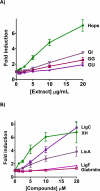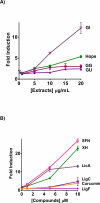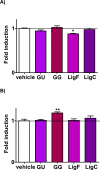Induction of NAD(P)H:Quinone Oxidoreductase 1 (NQO1) by Glycyrrhiza Species Used for Women's Health: Differential Effects of the Michael Acceptors Isoliquiritigenin and Licochalcone A
- PMID: 26473469
- PMCID: PMC4898475
- DOI: 10.1021/acs.chemrestox.5b00310
Induction of NAD(P)H:Quinone Oxidoreductase 1 (NQO1) by Glycyrrhiza Species Used for Women's Health: Differential Effects of the Michael Acceptors Isoliquiritigenin and Licochalcone A
Abstract
For the alleviation of menopausal symptoms, women frequently turn to botanical dietary supplements, such as licorice and hops. In addition to estrogenic properties, these botanicals could also have chemopreventive effects. We have previously shown that hops and its Michael acceptor xanthohumol (XH) induced the chemoprevention enzyme,
Nad(p)h: quinone oxidoreductase 1 (NQO1), in vitro and in vivo. Licorice species could also induce NQO1, as they contain the Michael acceptors isoliquiritigenin (LigC) found in Glycyrrhiza glabra (GG), G. uralensis (GU), G. inflata (GI), and licochalcone A (LicA) which is only found in GI. These licorice species and hops induced NQO1 activity in murine hepatoma (Hepa1c1c7) cells; hops ≫ GI > GG ≅ GU. Similar to the known chemopreventive compounds curcumin (turmeric), sulforaphane (broccoli), and XH, LigC and LicA were active dose-dependently; sulforaphane ≫ XH > LigC > LicA ≅ curcumin ≫ liquiritigenin (LigF). Induction of the antioxidant response element luciferase in human hepatoma (HepG2-ARE-C8) cells suggested involvement of the Keap1-Nrf2 pathway. GG, GU, and LigC also induced NQO1 in nontumorigenic breast epithelial MCF-10A cells. In female Sprague-Dawley rats treated with GG and GU, LigC and LigF were detected in the liver and mammary gland. GG weakly enhanced NQO1 activity in the mammary tissue but not in the liver. Treatment with LigC alone did not induce NQO1 in vivo most likely due to its conversion to LigF, extensive metabolism, and its low bioavailability in vivo. These data show the chemopreventive potential of licorice species in vitro could be due to LigC and LicA and emphasize the importance of chemical and biological standardization of botanicals used as dietary supplements. Although the in vivo effects in the rat model after four-day treatment are minimal, it must be emphasized that menopausal women take these supplements for extended periods of time and long-term beneficial effects are quite possible.
Figures








Similar articles
-
Evidence for Chemopreventive and Resilience Activity of Licorice: Glycyrrhiza Glabra and G. Inflata Extracts Modulate Estrogen Metabolism in ACI Rats.Cancer Prev Res (Phila). 2018 Dec;11(12):819-830. doi: 10.1158/1940-6207.CAPR-18-0178. Epub 2018 Oct 4. Cancer Prev Res (Phila). 2018. PMID: 30287522 Free PMC article.
-
Differential Effects of Glycyrrhiza Species on Genotoxic Estrogen Metabolism: Licochalcone A Downregulates P450 1B1, whereas Isoliquiritigenin Stimulates It.Chem Res Toxicol. 2015 Aug 17;28(8):1584-94. doi: 10.1021/acs.chemrestox.5b00157. Epub 2015 Jul 16. Chem Res Toxicol. 2015. PMID: 26134484 Free PMC article.
-
Evaluation of estrogenic activity of licorice species in comparison with hops used in botanicals for menopausal symptoms.PLoS One. 2013 Jul 12;8(7):e67947. doi: 10.1371/journal.pone.0067947. Print 2013. PLoS One. 2013. PMID: 23874474 Free PMC article.
-
The Multiple Biological Targets of Hops and Bioactive Compounds.Chem Res Toxicol. 2019 Feb 18;32(2):222-233. doi: 10.1021/acs.chemrestox.8b00345. Epub 2019 Jan 22. Chem Res Toxicol. 2019. PMID: 30608650 Free PMC article. Review.
-
Biological Effects of Licochalcones.Mini Rev Med Chem. 2019;19(8):647-656. doi: 10.2174/1389557518666180601095420. Mini Rev Med Chem. 2019. PMID: 30049263 Review.
Cited by
-
Hepatic metabolism of licochalcone A, a potential chemopreventive chalcone from licorice (Glycyrrhiza inflata), determined using liquid chromatography-tandem mass spectrometry.Anal Bioanal Chem. 2017 Dec;409(30):6937-6948. doi: 10.1007/s00216-017-0642-x. Epub 2017 Nov 10. Anal Bioanal Chem. 2017. PMID: 29127460 Free PMC article.
-
Evidence for Chemopreventive and Resilience Activity of Licorice: Glycyrrhiza Glabra and G. Inflata Extracts Modulate Estrogen Metabolism in ACI Rats.Cancer Prev Res (Phila). 2018 Dec;11(12):819-830. doi: 10.1158/1940-6207.CAPR-18-0178. Epub 2018 Oct 4. Cancer Prev Res (Phila). 2018. PMID: 30287522 Free PMC article.
-
Nrf2 Activation in Chronic Kidney Disease: Promises and Pitfalls.Antioxidants (Basel). 2022 Jun 3;11(6):1112. doi: 10.3390/antiox11061112. Antioxidants (Basel). 2022. PMID: 35740009 Free PMC article. Review.
-
Breast cancer prevention with liquiritigenin from licorice through the inhibition of aromatase and protein biosynthesis in high-risk women's breast tissue.Sci Rep. 2023 May 30;13(1):8734. doi: 10.1038/s41598-023-34762-z. Sci Rep. 2023. PMID: 37253812 Free PMC article.
-
DESIGNER Extracts as Tools to Balance Estrogenic and Chemopreventive Activities of Botanicals for Women's Health.J Nat Prod. 2017 Aug 25;80(8):2284-2294. doi: 10.1021/acs.jnatprod.7b00284. Epub 2017 Aug 16. J Nat Prod. 2017. PMID: 28812892 Free PMC article.
References
-
- Rossouw JE, Anderson GL, Prentice RL, LaCroix AZ, Kooperberg C, Stefanick ML, Jackson RD, Beresford SA, Howard BV, Johnson KC, Kotchen JM, Ockene J. Risks and benefits of estrogen plus progestin in healthy postmenopausal women: principal results From the Women's Health Initiative randomized controlled trial. JAMA. 2002;288:321–333. - PubMed
-
- Rees M. Alternative treatments for the menopause. Best Pract. Res. Clin. Obstet. Gynaecol. 2009;23:151–161. - PubMed
-
- Harman SM. Estrogen replacement in menopausal women: recent and current prospective studies, the WHI and the KEEPS. Gender Med. 2006;3:254–269. - PubMed
Publication types
MeSH terms
Substances
Grants and funding
LinkOut - more resources
Full Text Sources
Other Literature Sources
Miscellaneous

